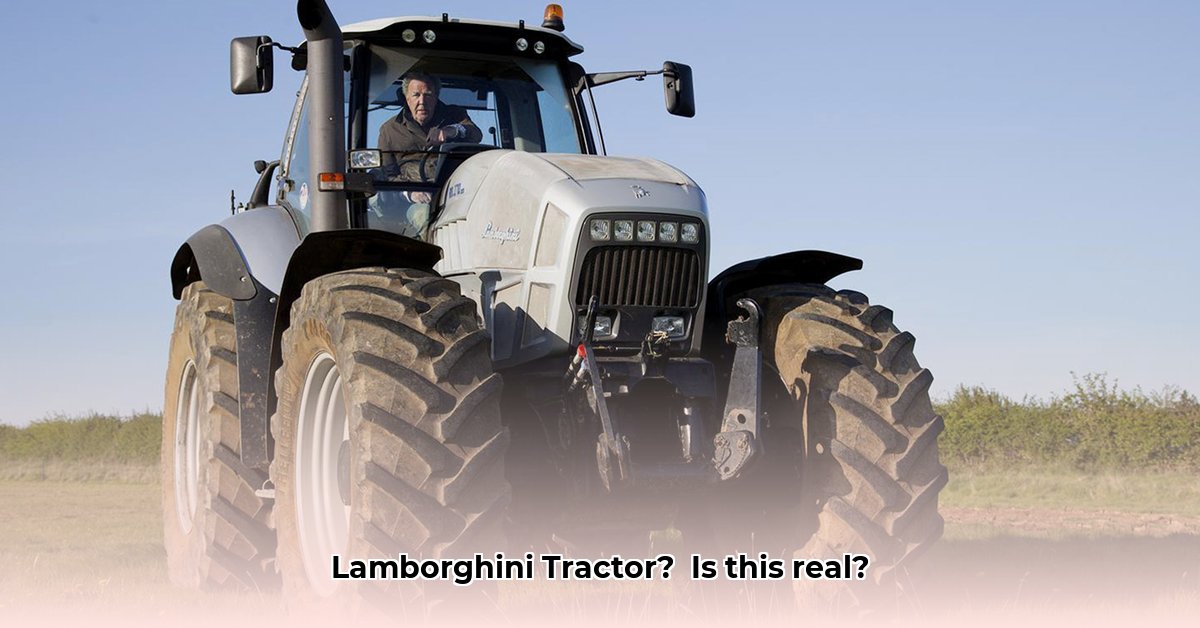
Assessing the Lamborghini R8.270: Power, Price, and Planet
The Lamborghini R8.270 tractor represents a significant leap in agricultural technology, boasting a potent 271 horsepower engine. However, its sustainability remains a complex question, demanding a nuanced analysis beyond simple horsepower figures. While its raw power promises increased efficiency and reduced labor costs, significant uncertainties surround its environmental impact and overall economic viability for various stakeholders. This review explores these facets, highlighting both the potential benefits and considerable challenges associated with adopting this powerful machine. For more details on Lamborghini tractors, see this helpful resource.
Raw Power and Potential Efficiency: A Cautious Optimism
The R8.270's substantial power output theoretically allows for faster field operations, potentially leading to reduced fuel consumption per acre. This potential for increased efficiency is a significant draw, offering farmers the prospect of lower operating costs. However, concrete data supporting these claims is presently lacking. Without verifiable fuel consumption figures under diverse operating conditions, any claim of superior fuel efficiency remains speculative. Further research is critically needed to quantify this potential benefit. Is the theoretical efficiency gain enough to offset other costs? Only further, rigorous data collection can answer this.
Sustainability Concerns: A Lack of Concrete Data
Assessing the R8.270's sustainability requires a comprehensive evaluation of its environmental impact. Currently, crucial data regarding fuel consumption per acre and lifecycle greenhouse gas emissions are unavailable. This significant data gap prevents any definitive conclusion on its long-term environmental performance. Furthermore, the tractor's high purchase price presents a substantial barrier for entry, particularly for small-scale farmers. Can the potential long-term gains justify the steep initial investment? This remains an open question, requiring a robust cost-benefit analysis beyond the scope of this review. The economic viability is also crucial for assessing sustainability.
Stakeholder Perspectives: A Multifaceted View
The R8.270’s impact varies significantly depending on the stakeholder:
- Large-scale farmers: Prioritize fuel efficiency and cost-effectiveness compared to existing models. Long-term concerns center around optimizing efficiency through precision farming techniques and minimizing fuel wastage.
- Small-scale farmers: Face immediate barriers concerning affordability, return on investment (ROI), and securing financing. Long-term considerations revolve around accessing more sustainable and economically viable equipment.
- Manufacturers (SAME): Must prioritize gathering and publishing comprehensive fuel consumption and emissions data. Continuous research and development (R&D) are crucial for designing more eco-friendly and cost-effective models.
- Policymakers: Should fund research into better farming practices and offer incentives for fuel-efficient agricultural machinery. Implementing regulations to encourage the adoption of lower-emission equipment is also critical.
Beyond Horsepower: Soil Compaction and Reliability
The R8.270's considerable weight (9.45 tons) raises concerns about soil compaction. This can negatively impact soil health, long-term productivity, and overall sustainability. Additionally, the machine's complexity might increase maintenance costs and downtime, impacting operational efficiency. These unintended consequences must be considered alongside the tractor's potential benefits.
Strategies for Reducing Fuel Consumption
Fuel efficiency is a major area of concern. Several strategies can help minimize fuel consumption in the Lamborghini R8.270:
- Regular Maintenance: Preventative maintenance is crucial. This optimizes engine performance and reduces fuel consumption. (Example: timely oil changes, filter replacements)
- Optimal Load Management: Avoid overloading the tractor, which leads to increased fuel consumption. (Example: Matching tractor capacity to the task)
- Tire Pressure Management: Maintain correct tire inflation; underinflation increases rolling resistance. (Example: Regularly checking and adjusting tire pressure)
- Efficient Driving Techniques: Smooth operation, consistent speed, and efficient gear selection minimizes fuel wastage. (Example: Avoiding aggressive acceleration and braking)
- Engine RPM Management: Avoid unnecessarily high engine speeds. (Example: Utilizing the engine's power management systems effectively)
- Technological Advancements: Utilize GPS-guided implement control, automatic power management, and variable transmission systems to refine operation.
Research Gaps and Future Directions
To fully evaluate the Lamborghini R8.270's long-term sustainability, substantially more detailed research is necessary. This should include rigorous testing under various farming conditions, comprehensive lifecycle analysis, and in-depth cost-benefit assessments across different farm scales. Further advancements in engine technology and tractor design are also critical.
Key Takeaways:
- The R8.270 offers significant power, but its long-term sustainability remains uncertain due to a lack of crucial data.
- Fuel efficiency, cost-effectiveness, and soil health must be thoroughly evaluated.
- Further research and technological advancements are vital for assessing and improving the tractor's sustainability.